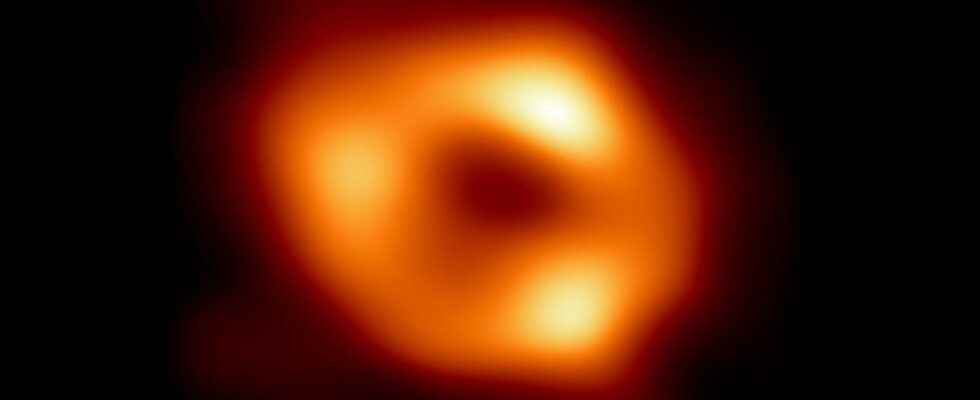A new technique to account for the rapid flickering of heated, bright matter falling on the Milky Way’s supermassive black hole has sorted out several accretion models for this compact star. The model selected by the observations is one of those that can be simulated and therefore provides an idea of what we should see in a few years with films showing the activity of the plasma radiating around Sgr A* , from images taken by members of the collaborationEvent Horizon Telescope.
The image, with a resolution record of the close environment of the supermassive black hole center of the Milky Way, a.k.a Sgr A*may suggest that this environment is rather calm, unlike those of the giant black holes behind the active nuclei of galaxies and especially those who are quasars. But it is nothing.
In fact, we thought we had images of Sgr A* at the same time as those of M87*. But we had to become disenchanted because the radiation in the area radio collected by the instruments of the collaboration Event Horizon Telescope (EHT) on the scale of our Blue Planet (and combined by skilful signal processing techniques making it possible to do what is called opening summary by interferometry as if we had a single instrument the size of the Earth) turned out to fluctuate much faster in time than we imagined. It had therefore taken longer to extract from the observations a characteristic image of Sgr A* and its close environment, beyond the purely fluctuating data. We can perhaps make a comparison with the difficulty of obtaining a clear image of an object in front of which is interposedair hot and turbulent.
Still, the rapidity of these fluctuations implies that we should be able to obtain, in the very near future, real films of the activity of the central black hole of the Milky Way. Furthermore, a signal which is noise in astrophysics for some measures and a source of information for others.
In a recent article submitted to Astrophysical Journal Letters but which can be read freely at arXiv, Sean Ressler from UC Santa Barbara, Lena Murchikovaof the’Institute for Advanced Study, and Chris Whitealso from Princeton University, were able to use the subtle, turbulent flicker of the Sgr A* image to build the most accurate model yet of the Milky Way’s supermassive black hole, providing insight into properties of the matter falling towards it, such as its structure and its movement.
For this, the three researchers also relied on numerical simulations possible models of the black hole’s matter supply and the consequences this has on the flickering of the radio radiation they produce. These are also consequences of several articles that the three astrophysicists have been publishing with their colleagues for some years. One of the simulations that gives a representation of what a movie of supermassive black hole activity over 4 million years might look like masses solar rays of the Milky Way can be seen in the video below.
This simulation shows a possible film, spread over about fifty hours and zoomed out, at the end of a day, of the fluctuations of the radiation of the gas falling towards the horizon of the events of the central black hole of the Milky Way Sgr A* . © Chris White, Princeton University
Several possible accretion models for Sgr A*
The simulations of theaccretion of matter for a spinning supermassive Kerr black hole at the heart of active galactic nuclei involves a disk of matter surrounded by a torus of dusty gas that gravitational attraction siphons off over time. The discs and tori can be supplied with material by gigantic filaments of cold matter falling on galaxies or by a star massive passing too close to the black hole. It will then be destroyed by the tidal forces of the supermassive black hole giving what is called in English the phenomenon of Tidal disruption event (or TDE), which can be translated as “tidal rupture event”.
The Sgr A* black hole does not, however, produce a active nucleus of galaxies. According to the joint work of the three astrophysicists, the model giving simulations which stick best to the flickering of Sgr A* observed is that deduced from the winds of matter produced by a few tens of type stars Wolf-Rayet (hot stars of several tens of solar masses) in orbit around the supermassive black hole. Accretion therefore produces neither disk nor torus, and the most accurate model also assumes that the giant black hole in our Galaxy is not rotating.
Ressler’s contributions come from a time he spent for years trying to construct the most realistic simulations to date of the gas around Sgr A*. He did this by incorporating observations of nearby stars and tracking the material they release as they orbit the black hole. Murchikova has developed a method to study the flickering of black holes on a timescale of seconds. White, on the other hand, had been working on the details of what happens to gas near black holes, when the effects of strong gravitational fields necessarily described by the general relativity are important, affecting the light which comes to us.
To learn more about the observations already made with the EHT and what they involve, one can read the comments in two articles that Futura published during the presentation of the first image of Sgr A* and which one must at Francoise Combes and Jean Pierre Luminet.
- The image revealing the supermassive black hole of the Milky Way commented by Jean-Pierre Luminet
- The image of the giant black hole of the Milky Way commented by Françoise Combes
Interested in what you just read?
